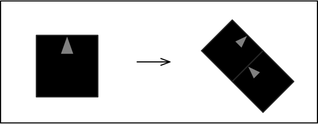pictures on the facing page show several more examples of fractal patterns produced in this way.
The details of the geometrical rules used are different in each case. But what all the rules have in common is that they involve replacing one black square by two or more smaller black squares. And with this kind of setup, it is ultimately inevitable that all the patterns produced must have a completely regular nested structure.
So what does it take to get patterns with more complicated structure? The basic answer, much as we saw in one-dimensional substitution systems on page 85, is some form of interaction between different elements—so that the replacement for a particular element at a given step can depend not only on the characteristics of that element itself, but also on the characteristics of other neighboring elements.
But with geometrical replacement rules of the kind shown on the facing page there is a problem with this. For elements can end up anywhere in the plane, making it difficult to define an obvious notion of neighbors. And the result of this has been that in traditional fractal geometry the idea of interaction between elements is not considered—so that all patterns that are produced have a purely nested form.



The pattern obtained by repeatedly applying the simple geometrical rule shown on the right. Even though this basic rule does not involve overlapping squares, the pattern obtained even by step 3 already has squares that overlap. But the overall pattern obtained after a large number of steps still has a nested form.



